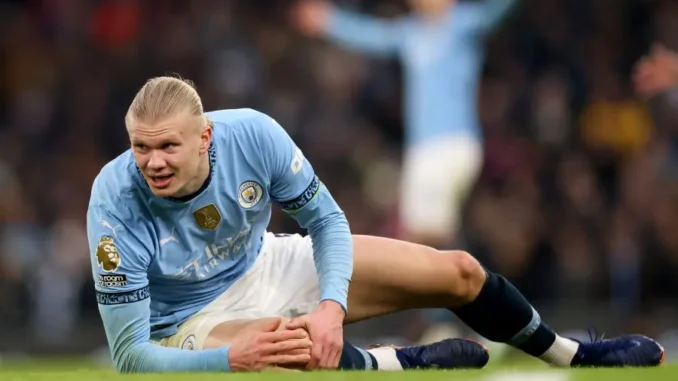
The tension was palpable, the air thick with concern. A hush fell over the stadium as Erling Haaland, Manchester City’s prolific goal-scoring machine, went down clutching his knee.1 For Pep Guardiola, his manager, the moment was fraught with worry. Haaland’s impact on the team is undeniable, his presence a constant threat to opposing defenses. The thought of losing him to injury, even for a short period, sent shivers down Guardiola’s spine. “Everyone was scared,” he later admitted, reflecting on the anxious moments that followed.
Haaland’s arrival at Manchester City had transformed the team’s attack. His ability to find the back of the net with remarkable consistency had elevated their game to another level. He wasn’t just scoring goals; he was scoring crucial goals, goals that changed the course of matches, goals that secured victories. His presence instilled fear in the hearts of defenders, forcing them to adjust their tactics and often leaving them helpless against his raw power and clinical finishing. He became the focal point of City’s attack, a player around whom the team’s strategy revolved.
Guardiola, a meticulous planner and a master tactician, understood the importance of Haaland to his team’s success. He had built his system around the striker’s unique skillset, maximizing his strengths and minimizing his weaknesses. The thought of losing such a key player, even temporarily, was a cause for significant concern. It wasn’t just about replacing his goals; it was about disrupting the team’s rhythm, altering their style of play, and potentially derailing their progress.
The moments after Haaland went down were agonizing for Guardiola. He watched anxiously from the sidelines, his face etched with worry, as the medical staff attended to his star striker. He knew that a serious knee injury could sideline Haaland for weeks, even months, potentially jeopardizing their title aspirations. The fear was palpable, not just for Guardiola but for the entire team, the fans, and everyone associated with Manchester City.
“Everyone was scared,” Guardiola reiterated, emphasizing the collective anxiety that gripped the stadium. It wasn’t just about the potential loss of a player; it was about the uncertainty, the unknown. No one knew the extent of the injury, and the longer the medical staff attended to Haaland, the more the tension mounted. The silence in the stadium was deafening, broken only by the murmurs of concerned fans.
Fortunately, after a few tense moments, Haaland was able to get back to his feet. He limped off the field, but the fact that he could walk, that he didn’t require a stretcher, provided a glimmer of hope. The initial relief was immense, but the worry lingered. Guardiola knew that further tests would be needed to determine the full extent of the injury.
The subsequent medical assessment revealed that Haaland had suffered a knock to his knee, but thankfully, it was not as serious as initially feared. The collective sigh of relief was audible, a shared sense of relief that swept through the stadium and beyond. The news was met with jubilation, not just by the fans but also by Guardiola, who knew how close he had come to losing his key striker.
Guardiola’s comments after the match revealed the depth of his concern. He acknowledged the fear that gripped everyone when Haaland went down, highlighting the striker’s importance to the team. He also emphasized the relief that followed the news that the injury was not serious. It was a reminder of the fragility of professional sport, the fine line between triumph and disaster, and the ever-present risk of injury.
The incident served as a wake-up call, a reminder of how quickly things can change in football. It underscored the importance of having depth in the squad, of being prepared for any eventuality. It also highlighted the crucial role of the medical staff, whose expertise and quick action helped to prevent a potentially serious injury from becoming a long-term problem.
For Haaland, the incident served as a reminder of the importance of taking care of his body and listening to its signals. He knew how close he had come to a significant injury, and he understood the need to be cautious and to prioritize his health. It was a learning experience, a reminder that even the strongest and most resilient athletes are vulnerable to injury.
The incident with Haaland’s knee served as a microcosm of the anxieties and uncertainties that are inherent in professional football. It was a reminder of the human element, the vulnerability of the players, and the emotional rollercoaster that comes with being a fan or a manager. And for Guardiola, it was a reminder of just how important Erling Haaland is to his team, not just for his goals, but for the fear he instills in opponents and the belief he inspires in his teammates.
Leave a Reply